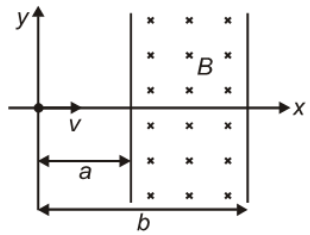The figure shows a particle of charge q and mass m moving with velocity v along the x-axis enters a region of the uniform magnetic field. The minimum value of v so that the charge q is deflected by an angle is

1.
2.
3.
4.

An electron is traveling along the x-direction. It encounters a magnetic field in the y-direction. Its subsequent motion will be:
1. Straight-line along the x-direction
2. A circle in the xz-plane
3. A circle in the yz-plane
4. A circle in the xy-plane
| 1. | \(B\) acts along the \(x\text-\)axis |
| 2. | \(B\) acts along the \(y\text-\)axis |
| 3. | \(B\) acts along the \(z\text-\)axis |
| 4. | \(B\) can act along any of the above direction for the net force to be zero |
1. \(10~\Omega\)
2. \(20~\Omega\)
3. \(8~\Omega\)
4. \(5~\Omega\)
The dots in the figure depict a magnetic field that is perpendicular to the plane of the paper and emanates from it. The trajectory of a particle in the plane of the paper is depicted by the curve \(ABC\). What exactly is the particle?

| 1. | Proton. | 2. | Electron. |
| 3. | Neutron. | 4. | It cannot be predicted. |
A long solenoid has 800 turns per meter length of the solenoid. A current of 1.6 A flows through it. The magnetic induction at the end of the solenoid on its axis is:
1.
2.
3.
4.
The unit of reduction factor of the tangent galvanometer is
1. Ampere
2. Gauss
3. Radian
4. None of these
In order to pass 10% of the main current through a moving coil galvanometer of 99 ohms, the resistance of the required shunt is :
1. 9.9 Ω
2. 10 Ω
3. 11 Ω
4. 9 Ω
When a \(12~\Omega\) resistor is connected in parallel with a moving coil galvanometer, its deflection reduces from \(50\) divisions to \(10\) divisions. What will be the resistance of the galvanometer?
1. \(24~\Omega\)
2. \(36~\Omega\)
3. \(48~\Omega\)
4. \(60~\Omega\)
A voltmeter has a resistance of G ohms and range V volts. The value of resistance used in series to convert it into a voltmeter of range nV volts is :
1. nG
2.
3.
4.






